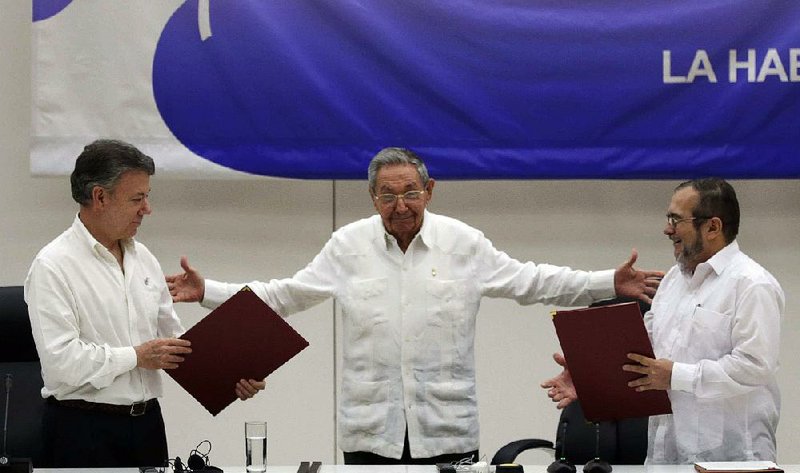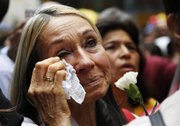HAVANA -- Colombian President Juan Manuel Santos and the head of the country's leftist rebels of the Revolutionary Armed Forces of Columbia, or FARC, agreed Thursday on a cease-fire and rebel disarmament deal that moves the country toward the end of a 52-year war that has left more than 220,000 people dead.
At a ceremony in Havana, Santos and FARC commander Rodrigo Londono, better known as Timochenko, watched as their lead negotiators signed a deal laying out how 7,000 rebel fighters will demobilize and hand over their weapons once a peace accord is implemented. In attendance were United Nations Secretary-General Ban Ki-moon, a special U.S. envoy and the presidents of Cuba, Chile, Venezuela and other Latin American countries.
In the Colombian capital, Bogota, hundreds of people watched the ceremony broadcast live on a giant screen, hugging each other, singing the national anthem and waving the Colombian flag as the two sides signed the deal. Some cried.
"Colombia got used to living in conflict. We don't have even the slightest memories of what it means to live in peace," Santos said. "Today a new chapter opens, one that brings back peace and gives our children the possibility of not reliving history."
A 15-year, U.S.-backed military offensive thinned rebel ranks and forced FARC's aging leaders to the negotiating table in 2012. In Santos, a U.S.-educated economist from one of Colombia's richest families, the rebels found a trusted partner who hailed from the conservative elite but wasn't bound by its prejudices.
Momentum was building toward a breakthrough after Santos said this week that he hoped to deliver a peace accord in time to mark Colombia's declaration of independence from Spain on July 20. But the latest agreement went further than expected.
In addition to a framework for the cease-fire, both sides agreed on a demobilization plan that will see guerrillas concentrate in rural areas and hand over weapons that had long been the vaunted symbols of their movement's origins as a self-defense force of peasant farmers attacked by the oligarchy-controlled state.
Negotiators in January agreed that the United Nations would be responsible for monitoring adherence to the eventual cease-fire and resolving disputes emerging from the demobilization.
The deal does not mark the start of a cease-fire, which would only begin with the signing of a final peace deal. This deal requires the rebels to completely put down their arms within six months after the signing of the final accord, which Santos said would take place in Columbia.
It says FARC fighters will move to 23 zones and eight camps where they will leave their arms and begin the process of moving back into civilian life. The arms will be delivered to U.N. monitors, who will use them to build three monuments to peace, according to the deal. The accord also includes security guarantees for the FARC during its planned transition to a peaceful political party.
With the latest advance, only a few minor items remain to be worked out for a peace accord. The biggest issue is how the final deal will be ratified and given legal protection so that it won't unravel should a more conservative government succeed Santos, who leaves office in 2018.
Santos also has promised to let Colombians vote on accepting the final accord in a national referendum, and his government isn't taking acceptance for granted.
A peace deal won't make Colombia safer overnight.
The proliferation of cocaine fueled the conflict longer than any other in Latin America and will remain a powerful magnet for criminal gangs operating in Colombia's remote valleys and lawless jungles. Colombia is the largest supplier of cocaine to the U.S., and only a small fraction of the country's 12,000-plus homicides last year had anything to do with the conflict.
"Although hard work remains to be done, the finish line is approaching and nearer now than it has ever been," U.S. Secretary of State John Kerry said in a statement from Washington.
Regional and international leaders were unreservedly enthusiastic about the imminent end of the Colombian conflict.
"We're getting closer to the end of the armed conflict than at any time in more than five decades," said Cuban President Raul Castro, a guarantor of the talks. "The two sides' decision represents a decisive step forward. The peace process can't turn back."
Information for this article was contributed by Michael Weissenstein, Joshua Goodman, Cesar Garcia, Libardo Cardona and Andrea Rodriguez of The Associated Press.
A Section on 06/24/2016

